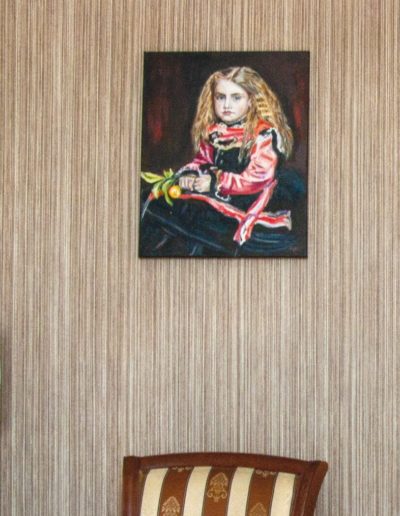Portrait of a girl
The portrait of a girl is an image captured in 1868 in the painting «A Souvenir of Velazquez». The original is in London at the Royal Academy of Arts. Its author is John Everett Millais (1829 — 1896) — a major English painter, one of the founders of the Pre-Raphaelite Brotherhood. Millet was born in Southampton and began drawing lessons at the age of nine. In 1838, when his abilities became apparent, the family moved to London. Academy, Pre-Raphaelite Brotherhood. In December 1840, at the age of 11, Millet entered the Royal Academy of Arts, becoming the youngest student in the history of the academy. Johnny studied at the academy for six years. In 1843 he received a silver medal for drawing. By the age of fifteen, he already had an excellent command of the brush. In 1846, his historical painting «Pizarro Captures the Peruvian Incas» was selected for the Academy’s summer exhibition. As a result, critics recognized her as the best at the entire academic exhibition of that year. Handmade oil painting.
The next year he received a gold medal for the painting «The Attack of the Tribe of Benjamin on the Daughters of Siloam.» In 1848, at one of the exhibitions, Millet met Holman Hunt and Dante Gabriel Rossetti and together with them founded the Pre-Raphaelite Brotherhood.
See other paintings by Evgenia Zragevskaya here: Still life with wild rosemary
His early work was characterized by considerable detail, notably Christ In The House Of His Parents (1850, London), which was considered overly realistic and was dubbed «outrageous» in The Times. However, Millet was not embarrassed, and he continued his work among the Pre-Raphaelites. In fact, the technical perfection of Millet’s paintings immediately distinguished him from other painters, therefore, Millet’s works were always accepted at the exhibitions of the academy, no matter how radical they were. He was also supported by the critic John Ruskin, who immediately saw Milla’s outstanding talent.
In the summer of 1853 Ruskin and his wife Effie invited Millet to go together for the summer to Glenfinlas. Millet and Effie fell in love and after her scandalous divorce from Ruskin they got married.
After the collapse of the brotherhood. The marriage betrayed Millet: in order to support the family, he had to create paintings faster and in larger quantities, and also sell them at a high price. Millet completely renounced the views and ideas of Pre-Raphaelism: in particular, Ruskin called the painting Sir Izumbras (1857), where the artist greatly departed from the Pre-Raphaelite technique, “not even a failure, but a disaster” [5]. In return, Millet gained immense popularity and a huge fortune, earning up to 30 thousand pounds a year. He became a portrait painter, partly a landscape painter (moreover, Millet painted landscapes not to order, but as a hobby — for himself) and became the first English artist to receive the title of baronet in 1885. In 1896 he was elected president of the Royal Academy of Arts. In the portraits of Millet, as a rule, he depicts famous people holding high public posts.
Currently, Millet is one of the most beloved by the British artists of the mid-19th century.








